For reasons I’ll divulge sometime, but not now, I’ve recently been thinking a lot about places tourists don’t go, but should, in Santiago. Should in the sense that they’d see a part of Santiago that’s not packaged and presented and polished and de-graffitied and super close the metro. They’d see a little piece of my Santiago.
One of the places my travels take me, both because there are two kind of decent bike paths there, and because it’s where my favorite wrench (bike mechanic) works, is San Diego. Recently, on a facebook group I belong to, people were poo-pooing, harumphing, and otherwise discrediting the bike mechanics on San Diego, and the whole street itself.
It’s ugly, it’s unkempt. It has what is probably the most unpleasant drinking establishment I’ve ever had the pleasure of entering (Las Tejas), and it’s Santiago’s own.
The truth is, as a traveler, you likely have no need for bike parts, nor kitchen supplies, and I don’t know what the heck you’d be doing down San Diego, other than getting an eyeful of what Santiago really looks like, and maybe stalking me. People will try to disabuse you of the idea of going, proclaiming it unsafe, dirty, unpleasant. Call me a glass-half-full kind of person. I can find beauty even in what’s ugly.
Let’s take a walk, shall we?
This ferris wheel, which festively floats among buildings and over a nice coil of razor wire, is the side view of Juegos Diana, an old school arcade, dark and loud (bing bing bing!) and open to the air. If you ask Santiaguinos if they ever went as children, they’ll tell you yes (but it used to be elsewhere) and sink into a reverie about how special and giant it seemed to them. Love that, though I do question the charm of the ferris wheel in its current location.
A typically, uninteresting apartment building along San Diego, this one has a view (see reflection) of “progress.”
Another piece of “progress,” which makes me ill.
Pretty, old apartment building that reminds me of a construction toy I had when I was a child called crystal climbers. People are out on the balconies because there’s a protest happening about a half a block away. Insert sprint here.
Technically, San Diego is a single street (the continuation of Bandera, on the south side of the Alameda, but to me it’s kind of the whole (unnamed neighborhood) from San Diego down to about Lord Cochrane, or maybe even the Pan American highway, which coincidentally, I have to cross to get to my apartment. Technically I’m not stalking COAS, the artist responsible for this guy, but every time I see one of his pieces (which is often, in Santiago and in other cities/towns), I try to take a picture. I kind of love them. I once had a fleeting email interchange with COAS, which I might go into, sometime.
One of the things I love about San Diego, is the extent to which it has resisted change. Like this hand-painted sign on metal, that I have passed a million times, and every time I do, it makes me smile. It is so simple, and in the face of modernity, probably considered pobre (poor).
It’s most of these things that make San Diego not fit for tourists, or so many Santiaguinos, oriundos and newbies alike will have you believe.
For my dollar (480 pesos at today’s rates, ugh), they don’t know jack.
And they don’t know San Diego, either.

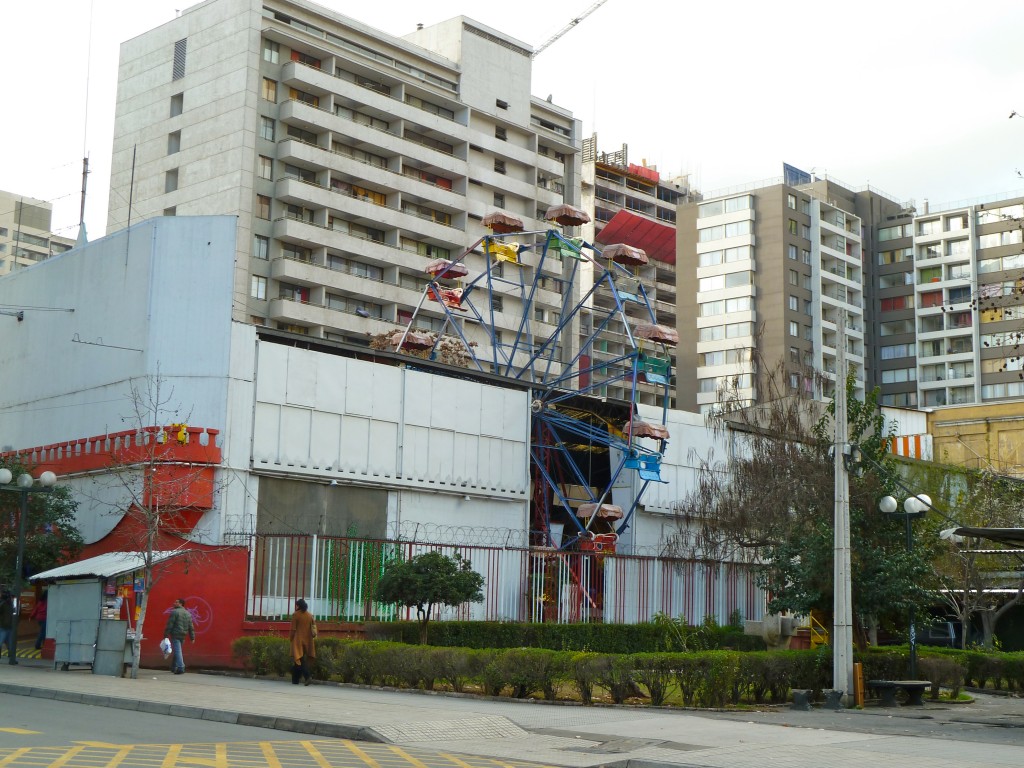



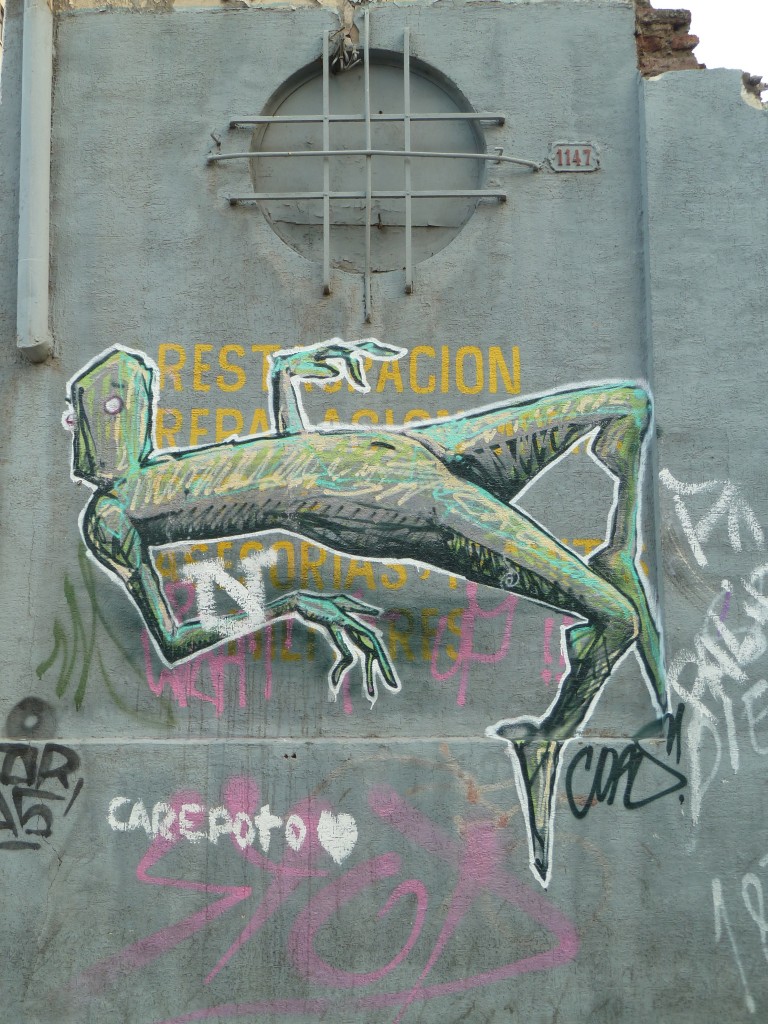
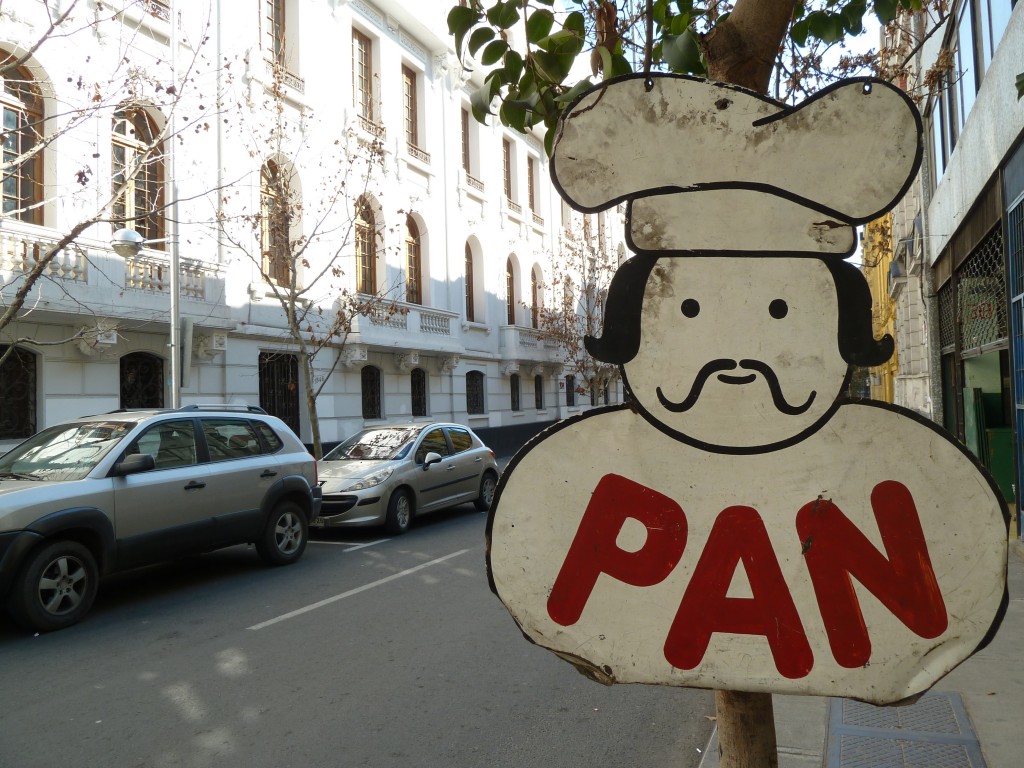
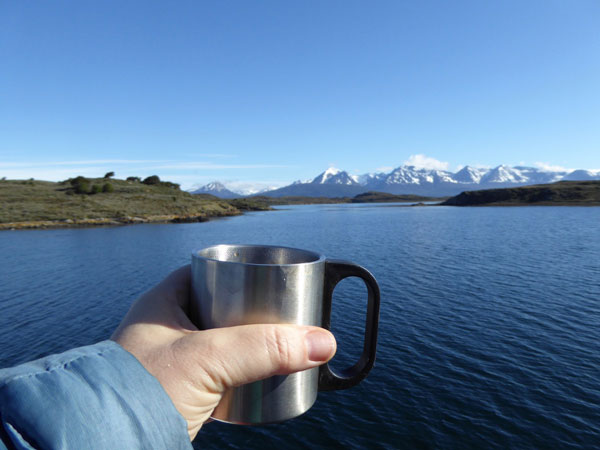

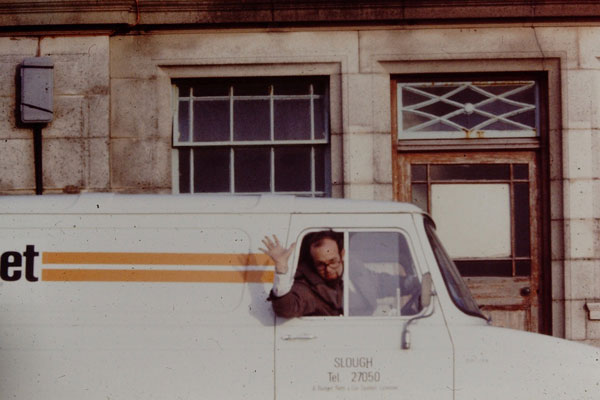


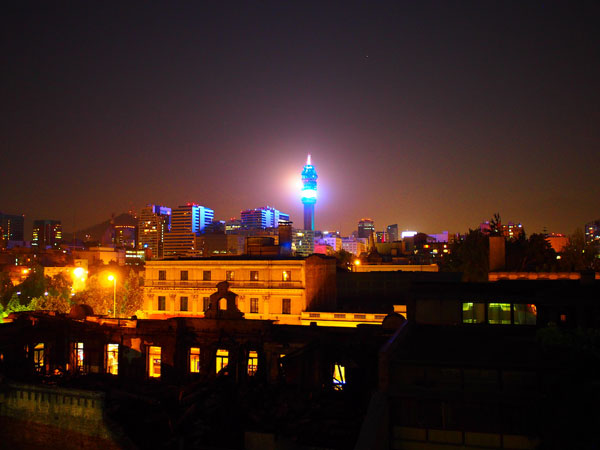



I look forward to “exploring” Santiago through your eyes, Eileen. I love off-the-beaten-track places and I LOVE “pan” signs. They are ubiquitous, but often unique in their own way.
But you live here! Come along. There’s plenty to go around. I love all the signs, especially the handwritten ones.
I’ve seen that ferris wheel several times and always think it’s just so random. Both the location and the way it juts out of an otherwise average-looking building make me cock my head a little.
Hace muchos, muchos años, cuando no existía la Alameda, sino un brazo del Mapocho al que los españoles bautizaron “la Cañada de San Lázaro” (y que a la altura de calle Brasil doblaba hacia el norte de vuelta al río), el viejo camino que los incas solían usar para atravesar el valle también cambió de nombre…
Hacia el norte de Santiago le llamban el Camino de Chile (lo que mantiene la teoría de que el “valle de Chile” era el nombre inca del uno de los dos valles, el del Aconcagua o del Mapocho), y por ser por donde entraron las tropas independentistas, la rebautizaron calle de la “Independencia”; y hacia el sur le llamaron “camino de San Diego”, por encontrarse en la esquina de la cañada con ella la iglesia de San Diego, hoy desaparecida… y su recorrido es la actual calle San Diego, Gran Avenida hasta San Bernardo y aun más allá.
(Las calles de Santiago suelen cambiar de nombre por eso, por haber sido creadas a medida que la ciudad crecía, o que le pasaban cosas a la ciudad)
Por esto de comunicar pueblos lejanos con Santiago, San Diego fue siempre una calle de mucho comercio, una de las primeras que se desarrolló durante el siglo XIX fuera del eje este-oeste.
esta pujanza industrial y comercial se mantuvo por mucho tiempo, hasta que en el Siglo XX ocurrieron fenómenos tales como la huida de la gente adinerada desde el centro hacia el oriente, la construcción del metro (que por un asunto de costos se prefirió construir por Panamericana en vez de San Diego), y ultimamente, el Transantiago, que alejó a muchos de los que por allí transitaban hacia otros lugares.
Puedes notar estos cambios en los viejos cines y teatros que ya no funcionan o han sido reconvertidos en otras cosas, las antiguas tiendas que han sido demolidas para dar pasos a esos horrendos edificios (La Mendocina, Cocilamp, Michaely, La Polar, Ripley y muchos otros)
San Diego ha cambiado mucho estos 15 años, y cambiará mucho más…
Gracias César, me encantó el resumen de la historia de la calle San Diego. Cada vez que pueda, recorro los barrios con los ciclorutas patrimoniales, y pasamos por grandes hitos tales como los ex teatros de ese barrio. Me fascina y me deprime ver los cambios en el nombre del “progreso.”
Pero pasa en muchas ciudades, pasó en el mismo barrio donde vivía en Washington, como dijiste: “la huida de la gente adinerada desde el centro hacia el oriente”. En el caso de donde vivía, era la gente adinerada que se fue a cualquier lado, y dejó para los menos organizados, los mas complicados a quedarse en ese barrio. Ahora se ha llenado de nuevo, con cada día mas gente adinerada que quiere aprovechar de los bajos costos de comprarse una casa por esos barrios. Y que se queja de todos los cambios que han sucedido desde que sus antepasados dejaron el lugar por que ya no lo valoraba. Por si te interesa, el barrio en Washington, DC se llama Colombia Heights, y se destruyó bastante en motines después del asesinato de Martin Luther King, Jr., y sufrió otros insultos también tales como descuido completo de edificios para que se cayeran.
Bueno, gracias otra vez por la info! Por favor, tenga a mano mas sobre Avda. Matta, que espero recorrer (de nuevo y una y otra vez) luego. Tb me queda Franklin, y muchos lugares mas! Y ahora, a leer mas Plataforma Urbana!
The graffitti isnt too bad…Thats a plus.
Hello was watching your website and is fine, I lived in the downtown specifically in the San Diego street and Maule St and you are right but is not touristic the area but is the real Santiago not the fake with lot of glam and taller copied buildings took from New York, the San Diego street or a side was build in 1908 the workers community Agustin Edwards it was the first of those kind of constructions as a solution to the give homes to people who works in small factories where was around the street. is the street not touristic but for a history class could be great even certain architectural demonstration of the 1900 when started the idea of cites etc as a solution to the popular house solution in the epoch, if want to understand the Santiago in the 1900 can be the perfect landmark.